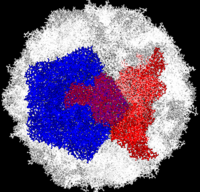ANTIVIRAL ACTIVITY of 3(2H)- and 6-CHLORO-3(2H)-ISOFLAVENES AGAINST HIGHLY DIVERGED, NEUROVIRULENT VACCINE-DERIVED, TYPE 2 POLIOVIRUS SEWAGE ISOLATES
Lester M. Shulman, Danit Sofer, Yossi Manor, Ella Mendelson, Jean Balanant, Anna Laura Salvati, Francis Delpeyroux, Lucia Fiore[1]
Molecular Tour
Poliovirus is a member of the Picornaviridae. Like other members of the Picornaviridae, poliovirus RNA is encapsulated in an icosahedral structure with axes of and symmetry formed from 60 each of viral capsid proteins VP1 (light blue), VP2 (pale green), VP3 (light orange) and VP4(light magenta). The binding site for the human poliovirus receptor is located . The VP1 of picornaviruses contain a hydrophobic pocket that is accessed through this canyon. This pocket is normally occupied by . The is observed binding in a pocket within the beta-barrel of VP1, in approximately the same location that natural pocket factors bind to polioviruses. SCH48973 forms predominantly hydrophobic interactions with the pocket residues.


